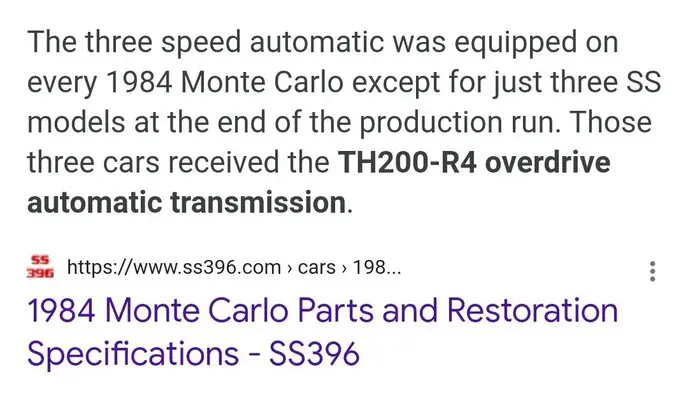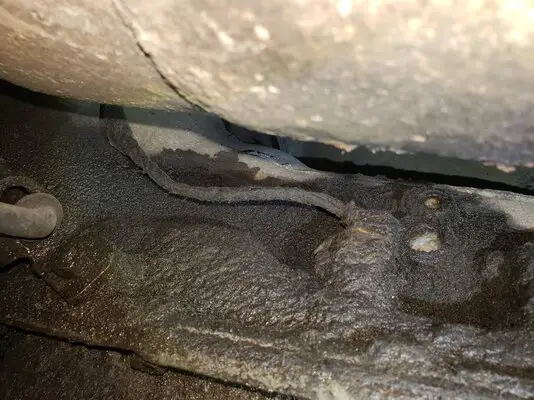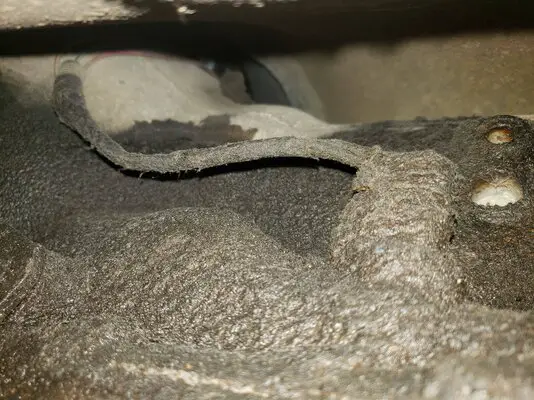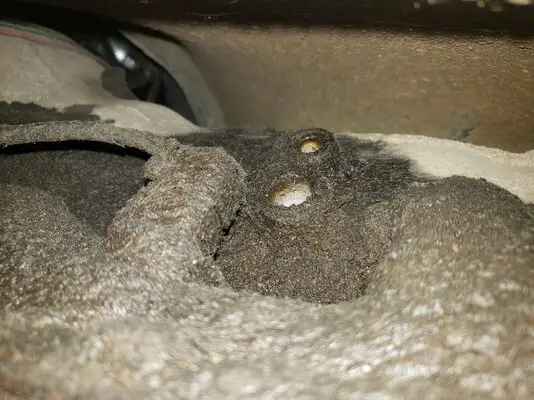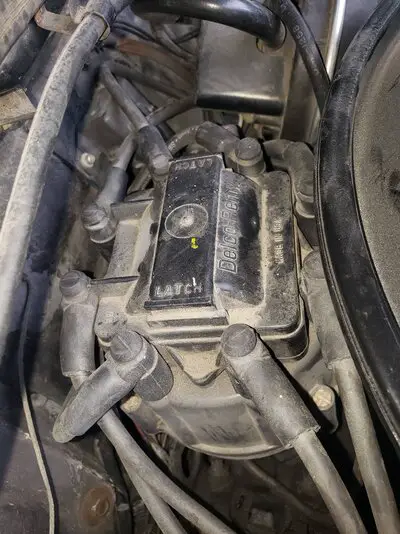By way of elaborating on some of my comments;
The first thing that ought to happen here is that you head for the book store or speed shop and score a repair manual for the year of your car. Haynes is one publisher; there are others. Apart from the general manuals there are component specific texts including those for transmissions. They are heavy on pictures to describe what is going on and include shots of the various pans that can be used to identify what your transmission is.
My comments on lockup versus non-lockup seem to require some clarification. The first thing here is that you apparently no longer have either the original engine or its matching transmission. But, what might still be lingering is the remains of the systems that supported that original combo. Without close up shots of the top of the engine it is difficult to decide if your swapper just stuffed in that 350 and then topped it with whatever used to be on the 305, or not.
Here is the point of division. IF the replacement engine came with its own transmission, and that t-body is a three speed as you say, then the probability is extremely high that you have no lock up in that transmission. However, and not trying to confuse things unnecessarily here, there was a variant of the 350 that was offered in 1980, that did come with the third gear lockup. (I actually have one on my shop floor right now that I just pulled from my 80 G-10 Van.) They display the same or a similar plug in as does the 700R4 and the 200R4 but there is only one wire plugged into it. The 350 also possesses a cable that gets attached to the throttle lever on the carb but this is NOT a TVC unit. There still ought to be a vacuum line running from the manifold to the vacuum module on the right side of the 350 t-mission near the back. This cable and vacuum line are all about how "passing gear or demand downshift" is achieved. Essentially when you hammer the throttle, the lever pulls the butterflies wide open as well has pulling that cable out to its limit, AT the same time the vacuum signal off the manifold increases which tells the module that the vehicle is accelerating hard and that the t-mission either has to downshift to help the acceleration or to keep it in action until the throttle is eased off at which point you would feel the shift into third and the engine rpms would drop.
As for what the 305 had to accompany it for a transmission, that was likely a TH200R4 as they were common around that time. That was a 4spd, and it did have the lockup electrical connection located on the drivers side of the case. That plug had two wires as did the 700R4, both of whom had the venerable 350 case as their grandfather. The 200 also comes with a cable that IS NOT for demand down shift. That cable is called the TVC for Transmission velocity cable and how it works is to open and close a valve internal to the t-mission governing internal ATF fluid line pressure and shifting gears through the range as the fluid pressures call for it. NOT going to go into how to adjust it. I just went through that drill and PITA does not begin to describe it.
Do be aware that I am discussing what used to be in the car, not what me there now.
From your description of the carb, it may have a better future as a paperweight. Both Edelbrock and Holley make spread bore style carbs with the electric choke. Electric chokes are something of a nuisance because as soon as the key is turned off the choke element tries to close the primary choke plate. Hot or warm starts get done without any gas pedal input. Whacking the throttle to send gas down stream is about guaranteed to flood it. Be aware that the secondaries will open only when there is enough vacuum to pull them open which brings us back to passing again. At idle and around town, it is the primary side of the carb that does all the work.
The only sure way I know to determine whether the mill is roller or non roller is to lift the manifold and look for the presence of the frog plate in the lifter valley.
The ECM or EEE that the car came with is NOT available aftermarket. They are obsolete. There are a couple of experienced greyer beards on this board who can talk you through adapting a cpu type processing system to run the car if you really want to go there. It can be done but.... the wiring is a bear.
Hope this clears up some of my initial information feed.
Nick
The first thing that ought to happen here is that you head for the book store or speed shop and score a repair manual for the year of your car. Haynes is one publisher; there are others. Apart from the general manuals there are component specific texts including those for transmissions. They are heavy on pictures to describe what is going on and include shots of the various pans that can be used to identify what your transmission is.
My comments on lockup versus non-lockup seem to require some clarification. The first thing here is that you apparently no longer have either the original engine or its matching transmission. But, what might still be lingering is the remains of the systems that supported that original combo. Without close up shots of the top of the engine it is difficult to decide if your swapper just stuffed in that 350 and then topped it with whatever used to be on the 305, or not.
Here is the point of division. IF the replacement engine came with its own transmission, and that t-body is a three speed as you say, then the probability is extremely high that you have no lock up in that transmission. However, and not trying to confuse things unnecessarily here, there was a variant of the 350 that was offered in 1980, that did come with the third gear lockup. (I actually have one on my shop floor right now that I just pulled from my 80 G-10 Van.) They display the same or a similar plug in as does the 700R4 and the 200R4 but there is only one wire plugged into it. The 350 also possesses a cable that gets attached to the throttle lever on the carb but this is NOT a TVC unit. There still ought to be a vacuum line running from the manifold to the vacuum module on the right side of the 350 t-mission near the back. This cable and vacuum line are all about how "passing gear or demand downshift" is achieved. Essentially when you hammer the throttle, the lever pulls the butterflies wide open as well has pulling that cable out to its limit, AT the same time the vacuum signal off the manifold increases which tells the module that the vehicle is accelerating hard and that the t-mission either has to downshift to help the acceleration or to keep it in action until the throttle is eased off at which point you would feel the shift into third and the engine rpms would drop.
As for what the 305 had to accompany it for a transmission, that was likely a TH200R4 as they were common around that time. That was a 4spd, and it did have the lockup electrical connection located on the drivers side of the case. That plug had two wires as did the 700R4, both of whom had the venerable 350 case as their grandfather. The 200 also comes with a cable that IS NOT for demand down shift. That cable is called the TVC for Transmission velocity cable and how it works is to open and close a valve internal to the t-mission governing internal ATF fluid line pressure and shifting gears through the range as the fluid pressures call for it. NOT going to go into how to adjust it. I just went through that drill and PITA does not begin to describe it.
Do be aware that I am discussing what used to be in the car, not what me there now.
From your description of the carb, it may have a better future as a paperweight. Both Edelbrock and Holley make spread bore style carbs with the electric choke. Electric chokes are something of a nuisance because as soon as the key is turned off the choke element tries to close the primary choke plate. Hot or warm starts get done without any gas pedal input. Whacking the throttle to send gas down stream is about guaranteed to flood it. Be aware that the secondaries will open only when there is enough vacuum to pull them open which brings us back to passing again. At idle and around town, it is the primary side of the carb that does all the work.
The only sure way I know to determine whether the mill is roller or non roller is to lift the manifold and look for the presence of the frog plate in the lifter valley.
The ECM or EEE that the car came with is NOT available aftermarket. They are obsolete. There are a couple of experienced greyer beards on this board who can talk you through adapting a cpu type processing system to run the car if you really want to go there. It can be done but.... the wiring is a bear.
Hope this clears up some of my initial information feed.
Nick


